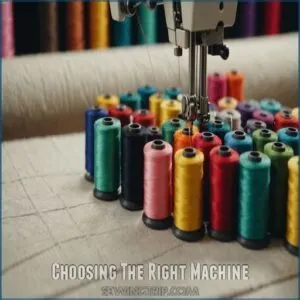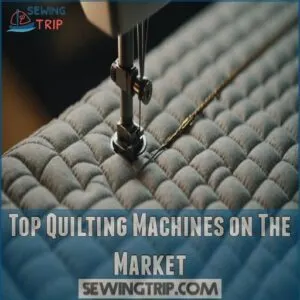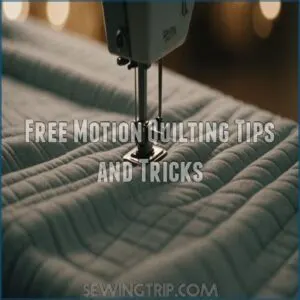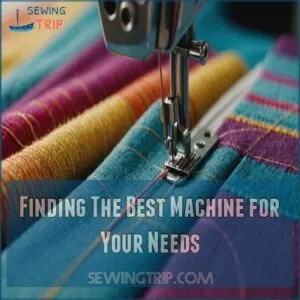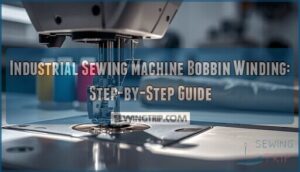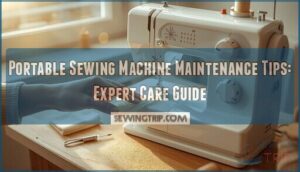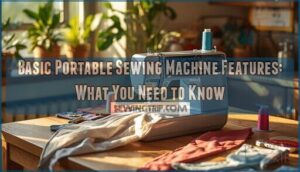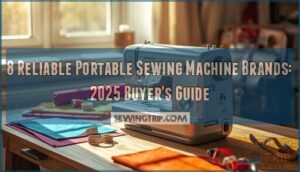This site is supported by our readers. We may earn a commission, at no cost to you, if you purchase through links.
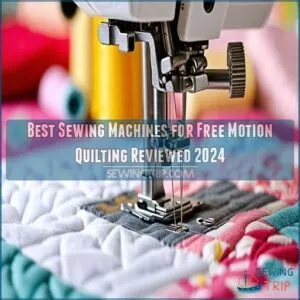
Top models like the Juki HZL-F300 and Janome MC6650 offer ample throat space and smooth speed control, making quilting a breeze.
Key features to look for include a free-motion foot, adjustable stitch length, and a handy needle down button.
Don’t forget budget-friendly options like the Brother CS7000X.
Each machine has its quirks, so imagine it as your quilting partner.
Curious about how to avoid common quilting pitfalls? Stay tuned for tips on mastering free motion quilting!
Table Of Contents
Key Takeaways
- When you’re choosing a sewing machine for free motion quilting, consider the importance of quilting machine features that allow for precision and control, prioritize features like a free-motion foot, smooth speed control, and ample throat space for ease and precision.
- Consider both premium models like the Juki HZL-F300 or budget-friendly options such as the Brother CS7000X to match your needs and budget without compromise.
- Setting up your machine correctly, including lowering feed dogs and selecting the right needle and thread, is crucial for seamless free motion quilting.
- Beginners can start with user-friendly machines that emphasize ease of use and essential quilting features.
Choosing The Right Machine
When you’re choosing the right sewing machine for free motion quilting, consider features like throat space and the ability to lower feed dogs.
It’s like picking the perfect pair of shoes—comfort and functionality are key, not just the shiny extras.
Key Features for Free Motion Quilting
So, you’re diving into the wonderful world of free-motion quilting? Fantastic! To master this technique, your machine needs some key features.
Look for these must-haves:
- A free-motion foot (also called a darning foot or quilting foot).
- The ability to easily lower feed dogs (or drop feed dogs).
- Smooth speed control, for consistent stitching.
- A handy needle down button, for precise placement.
- Adjustable stitch length, to experiment and find your rhythm.
Getting these features will help you create beautiful, flowing designs!
Importance of Throat Space
Throat space plays a pivotal role when selecting your quilting machine.
For the best results, consider exploring top-rated free-motion quilting sewing machines online, such as those found on websites specializing in best free motion sewing machines.
While free-motion quilting requires finesse and skill, ample throat space gives you room to breathe, especially with larger quilts.
It’s like having an extra pair of hands holding your fabric without the backbreaking effort!
Consider your quilting needs and explore machine options to find the best fit for you.
Types of Sewing Machines for Quilting
While a spacious throat space is handy for quilting, choosing the right machine type is just as important.
You can quilt on any sewing machine, but models like the Juki Haruka TL18QVP, known for its automatic needle threading, make life easier, but models crafted for quilting make life easier.
Consider machines from top brands like Juki and Bernina.
They offer advanced features like wider sewing surfaces.
Don’t forget budget-friendly options and beginner-friendly models for flexibility.
Considerations for Beginners
When exploring different types of machines, beginners should focus on specific features.
Start by considering these key points:
- Sewing Machine Basics: Make sure it handles straight and reverse stitches easily.
- Quilting Supplies Compatibility: Check for adjustable settings.
- Practicing Techniques: Choose one that’s intuitive.
Keep these tips handy—it makes quilting stitch practice a breeze!
Budgeting for a Quilting Machine
Setting a budget for a quilting machine is like planning a quilt: layer by layer.
Consider used quilting machines for budget-friendly options.
Prioritize features like free motion quilting capabilities or a solid free motion stitch.
Think about DIY quilting tools to complement your projects.
Whether saving or financing, make sure your choice balances necessity with your quilting dreams.
Top Quilting Machines on The Market
If you’re on the hunt for the top quilting machines in 2024, many great options are available, such as the Singer Start 1304 Sewing Machine, a best quilting machine that is both lightweight and portable.
Some machines stand out with their pros and cons, catering to various needs, skill levels, and budgets.
Consider these highlights: When choosing a quilting machine, you should look for features like free motion quilting capabilities, which can make a huge difference in your quilting experience.
- Brother XR9550: Perfect for hobbyists, it’s lightweight and user-friendly, ideal for both traditional quilting and free motion quilting with over 150 stitch options.
- Janome New Home Blue Couture: A mechanical wonder, this one’s priced attractively for beginners who appreciate simplicity and efficiency.
- Brother HC1850: Known for its adaptability, it’s an all-around gem for mid-arm quilting and more advanced projects.
Each machine offers unique features, so you can feel like a quilting maestro without breaking the bank.
Free Motion Quilting Tips and Tricks
You’ve got your sewing machine ready, but mastering free motion quilting can feel like trying to pat your head and rub your belly at the same time.
With the right setup and a few handy tricks, you’ll be stitching intricate designs and avoiding common pitfalls in no time, making your quilting journey as smooth as satin.
Setting Up Your Machine for FMQ
Now that you’ve picked your perfect machine, let’s get it ready for free motion quilting, and if you’re still looking for the best sewing machines for free motion quilting and embroidery, check out some top options here for best models.
First, lower the feed dogs.
Attach a darning foot (or open-toe quilting foot).
Adjust your stitch length to zero.
Don’t forget to check your bobbin tension!
A detachable table helps with larger projects.
You’re almost ready to express your quilting creativity!
Choosing The Right Needle and Thread
You’ve got your machine ready, but don’t overlook your needle and thread combo for free motion quilting.
Choose a needle gauge and thread weight that align—like a dance partner—with your fabric.
Consider fabric compatibility and needle sharpness.
For free motion embroidery and those intricate decorative stitches, using the right thread type and needle position means harmony in motion.
Mastering Free Motion Quilting Techniques
Mastering free motion quilting involves a bit of finesse and creativity.
Get started with practice and remember these tips:
- Choose the right quilting foot for precision.
- Experiment with quilting thread types to find your favorite.
- Control fabric tension carefully for consistent stitches.
- Explore various quilting designs for inspiration.
- Use quilting accessories, like gloves, for better grip.
Happy quilting!
Common Mistakes to Avoid in FMQ
After mastering techniques, watch for common mistakes in FMQ, like ignoring tension issues or poor needle selection.
Imagine this: your fabric choice can lead to mishaps if not suitable, or stitch length inconsistency can make speed control tricky.
| Mistake | Solution |
|---|---|
| Tension issues | Adjust tension settings |
| Needle selection | Choose correct needle |
| Fabric choice | Test fabric suitability |
| Stitch length | Maintain consistent size |
| Speed control | Practice even pace |
These quilting tips prevent headaches!
Finding The Best Machine for Your Needs
Finding the perfect sewing machine for your quilting projects can feel like choosing the right flavor of ice cream—there’s a lot to think about, especially when considering Brother machines for quilting, but your choice will make all the difference.
You’ll want to explore factors like price, features, and brand reputation.
There’s no harm in taking a machine for a test "stitch" before committing to make sure it suits your needs.
Factors to Consider When Buying a Quilting Machine
When you’re hunting for the perfect quilting machine, think of it like choosing a sewing buddy. Budget matters, but don’t overlook features!
- Brand reputation: Trustworthy brands often promise durability and reliability.
- Stitch options: More variety means more creative freedom.
- Ease of use: A user-friendly machine keeps the quilting joy alive.
Happy stitching!
Researching and Comparing Different Models
Deciding between various sewing machines can feel like choosing a favorite ice cream flavor—tricky, but exciting!
Some machines, like those from Bernina and Janome sewing machines, stand out for their quality and precision, especially for techniques like free motion quilting.
Consider features, pros and cons, and price comparison to find your perfect match.
Don’t overlook brand reputation and user reviews; they tell tales of true performance.
For free motion quilting, the best machines sing praises in quilting classes and reviews alike.
Test Driving a Machine Before Buying
Many sewing machine dealers offer demos; take advantage! Before committing, try several machines. You can also read reviews on websites that sell products related to free motion quilting machines.
Prioritize these key aspects during your hands-on experience: 1. Smoothness of free motion quilting.
- Ease of thread tension adjustment.
- Comfort and ergonomics.
Frequently Asked Questions (FAQs)
Can a sewing machine do free motion quilting?
Although a mid-level sewing machine like the Baby Lock Jazz with drop-in feed dogs that allow for free motion quilting capabilities, Absolutely, you can do free motion quilting with a regular sewing machine.
Lower the feed dogs, attach a free motion foot, and enjoy the creative freedom.
It’s like drawing with thread—give it a try and have fun! .
What is the best free motion quilting machine?
About 70% of quilters use domestic machines for free motion.
Consider the Janome Horizon 8200 QCP for its large throat space and versatile quilting feet.
It combines reliability with ease, letting creativity flow effortlessly.
What is free motion quilting (FMQ)?
Free motion quilting lets you express your creativity by moving fabric freely under a sewing machine needle to create beautiful patterns.
It’s like drawing with thread without using feed dogs, giving you artistic control over your designs.
What is free motion quilting?
Picture quilting as an arcade game where you control the fabric’s path under the needle.
Free motion quilting lets you create intricate, flowing designs by moving the quilt freehand, skipping those feed dogs altogether.
What brand is the quilters choice sewing machine?
The Quilter’s Choice sewing machine is a Baby Lock model.
It’s designed for quilting, boasting features like a quick-set bobbin winder and numerous specialty feet.
You’ll find it’s a great choice for your quilting needs!
Can any sewing machine do free motion quilting?
You can definitely try free motion quilting on most sewing machines, as long as you can lower the feed dogs and use a suitable presser foot.
It’s like doodling on fabric—fun, creative, and uniquely yours!
What machine does Leah Day use?
Did you know that some quilts take over 12 hours just to stabilize?
Leah Day often uses a Janome 15000 for her quilting projects.
It’s perfect for intricate designs and offers the freedom to explore creative quilting techniques.
What is the best stitch length for free motion quilting?
Stitch length in free motion quilting depends on your thread and speed.
Generally, aim for 5-5 mm, but adjust as needed.
Faster movements create shorter stitches, while slower movements result in longer ones.
Experiment for best results.
How do I maintain my sewing machine?
Worried about time? Maintaining your sewing machine is quicker than you think.
Unplug, clean lint with a brush, oil moving parts sparingly, and change needles regularly.
Routine care prolongs machine life, ensuring smooth, fuss-free sewing adventures.
What threads work best for quilting?
You’ll find 50wt threads like Aurifil ideal for quilting, offering a perfect balance for piecing and quilting.
They blend seamlessly into fabric, ensuring durable yet invisible stitching.
Always choose high-quality cotton for lasting quilts.
Are there budget-friendly quilting machines?
Absolutely, budget-friendly quilting machines exist!
Consider the Brother CS7000X, offering a balance of features and affordability.
It’s lightweight, portable, and includes 70 stitches—perfect for beginners ready to quilt their way into creative mastery.
Can beginners use free motion quilting machines?
While machines like the Singer quilting machines, with their wide selection of built-in stitch applications and one-step buttonhole functions, can enhance your quilting workflow. You can totally free-motion quilt on a regular sewing machine. It’s like doodling with thread—no measuring needed! Just lower your feed dogs and enjoy the creative freedom.
How often should I clean my machine?
Consider cleaning your sewing machine after every 2-3 bobbins, especially if you’ve been sewing with lint-heavy fabrics like fleece or flannel.
Regular maintenance keeps your machine purring like a kitten and saves you future headaches.
Conclusion
Imagine this: you’ve mastered the art of free motion quilting, turning your creative visions into beautifully stitched reality.
By choosing one of the best sewing machines for free motion quilting reviewed, like the Juki or Janome, you’ll have the perfect partner by your side.
Remember, it’s all about features—ample throat space, adjustable stitches, and the trusty needle down button.
Budget wisely, test drive potential partners, and soon, quilting magic will flow effortlessly from your fingertips.
Happy quilting!

